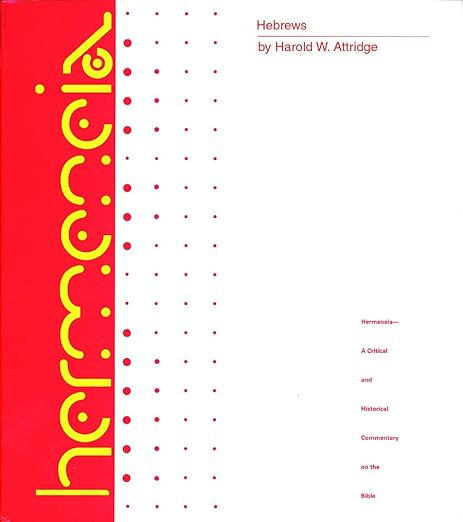Attridge, Harold W. Hebrews: A Commentary on the Epistle to the Hebrews. Ed. by Helmut Koester, Hermeneia—A Critical and Historical Commentary on the Bible. Fortress Press, 1989. Hardcover, 438 pages. ISBN: 978-0-8006-6021-5. $69.00.
I once spoke with the renowned New Testament scholar Tom Schreiner about the challenges of writing commentaries. Schreiner, who has authored several himself, told me that the most difficult part wasn’t the translation work, the endless reading, or the editorial process. Rather, it was knowing that most commentaries have a shelf life of only about twenty years before publishers start looking for a replacement. While that’s generally the case, Harold Attridge’s Hebrews is a remarkable exception. Nearly forty years later, it remains in print and is still considered one of the definitive single-volume commentaries on the book.
Summary:
Attridge gets straight to the point, devoting just 31 concise—but helpful—pages to introductory matters: authorship (ultimately unknown, pp. 1–6), date (estimated between 60–100 CE, pp. 6–9), and audience (likely somewhere in Rome, pp. 9–13). In the main commentary, his goal isn’t to break new ground—a rarity in publishing—but to provide a broad, balanced overview of scholarly views on key themes or pericopes. He summarizes the evidence clearly and often lands somewhere in the middle. His critiques of differing positions are measured, fair, and grounded in the evidence, without veering into dogmatism. Each pericope begins with a translation, followed by a brief analysis and then a verse-by-verse commentary. Attridge consistently engages with the Greek text but only emphasizes it when it directly impacts interpretation. He frequently draws connections to Philo, as well as to the Dead Sea Scrolls, Platonic philosophy, and the writings of Paul, adding depth and context throughout.
The commentary includes fourteen excursuses—concise, essay-style discussions that explore major theological themes in Hebrews. The first, on the theme of Sonship (pp. 54–55), examines the debate over pre-existence Christology in relation to Hebrews 1:5’s citation of Psalm 2:7. Attridge presents the two main scholarly perspectives and ultimately concludes that Hebrews does not offer a systematic theology of Christ’s pre-existence. Instead, its focus is on Christ’s superiority and exaltation over the angels (p. 55). A more pointed excursus, “Priesthood and Sonship” (pp. 146–147), addresses the debate over when Christ became the exalted Son and High Priest. Attridge critiques efforts to pinpoint a precise moment, arguing instead that Christ’s priesthood is a natural extension of his exalted status. He writes, “Attempts to be overly precise about when Christ became High Priest ignore this complexity” (p. 147), emphasizing the integrated and nuanced nature of the text’s theological vision. One of the more intriguing excursuses focuses on the enigmatic figure of Melchizedek (pp. 192–195). Attridge offers a concise overview of how Melchizedek appears across various sources, including Philo, 11QMelch, and the Gnostic texts from the Nag Hammadi codices. While acknowledging these parallels, he ultimately concludes that the origin of the Melchizedek figure as a heavenly being remains unclear. The tradition is rich and varied, but its precise roots are elusive.
Attridge proves especially insightful throughout his commentary on the text. Early on, in his discussion of Hebrews 1:4, he cautions readers against overemphasizing the idea that Christ “became” (γενόμενος) superior to the angels. As he explains more fully in his excursus on Sonship, the author of Hebrews is less concerned with when Christ became superior and more focused on the fact that he is (p. 47). A particularly helpful moment appears in his treatment of Hebrews 5:7, which describes Christ in anguish. Many scholars—including the one writing this review—have read this as an allusion to Jesus’ prayer in Gethsemane from the Synoptic Gospels. Yet Attridge argues persuasively that the prayers mentioned in 5:7 “cannot be simply derived from any known tradition” (p. 148), since they include elements the Synoptic accounts do not explain. Another standout insight comes in his interpretation of Hebrews 9:23, a verse often read through the lens of apocalyptic or new covenant imagery, with the idea that heavenly things need purification. While acknowledging these readings as plausible, Attridge notes that they don't align well with the broader logic of Hebrews. Instead, he proposes that the purification referenced is metaphorical—referring to the cleansing of heart and mind. In his view, Hebrews 9:23 points to “fundamental Christian convictions,” where inner transformation occurs not through human effort but through God’s action in Christ (p. 262).
Review:
In summary, Attridge’s commentary has rightfully earned its place as the definitive work on Hebrews. He skillfully avoids common scholarly pitfalls, such as getting lost in overly technical debates or leaning too heavily on one interpretive tradition. Instead, he keeps the reader grounded in the major themes and issues of the text, all while maintaining a clear, steady pace. One common critique of the commentary is that it doesn’t offer anything new. But in my reading, that simply doesn’t hold up. Time and again, Attridge offers concise yet incisive overviews of the scholarly consensus—only to challenge or nuance it in thoughtful ways. While he doesn’t deliver any headline-grabbing scholarly bombshells, he does engage the material with quiet authority and subtle insight, often nudging the discussion in fresh directions. Nearly forty years on, Attridge’s Hebrews remains the standard—and for good reason. To that, let us chant: forty more years!




My word of the day is now "pericope". Good word and definitely using way too much in casual conversations for the next couple days😆